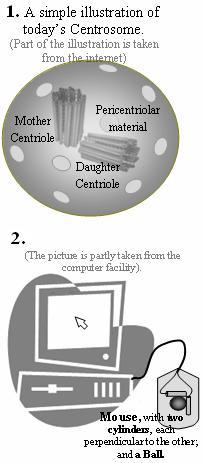Centrioles that are perpendicular to each other
Reinarto W Hadipriono - 23.09.2011 09:06
An interesting condition in the world of biology is the fact that the Centrioles inside the cell is Perpendicular to Each Other

Image
In the course of its evolution, the centre or the core of the Cell-to-be eventually has to make its way towards the edge, to the spot currently occupied by the Centrosome. Certainly, the condition of the Centrosome of the past is not at all similar to that of today’s Centrosome in that the latter has, by its constant exposure to external influences, been undergoing various changes.
In evolution, it is not uncommon that something that once looked simple may, millions of years later, turn into something extremely intricate. Even something that looks as simple as a ball when it first comes into being may later, by evolution, takes the form of rows of tubes so configured that they look like some work of art of an artist. If one is to glance at the Mother Centriole and the Daughter Centriole, one may instantly come to think that there must be a reason for their being perpendicular to each other.
With the body of the Cell-to-be twisted when it divides, all the inner parts of the Cell-to-be in the whole body are affected. The Centrosome-to-be is no exception: the spinning of all its Microtubules-to-be affects it too.
This could perhaps be compared with the mouse of a computer. Equipped with a ball that can roll in any direction, the mouse can easily direct the cursor on the screen in search of whatever one may desire. All one has to do is to “click” the mouse. This is so, because in the inner part of the compartment that holds the mouse, just at the side of the mouse, there are two cylinders, each perpendicular to the other. Thus, when the ball rolls, it touches the cylinders, thereby causing them to spin/twist and direct the Cursor on the screen to move to whichever direction as desired. The horizontal cylinder moves the Cursor vertically, while the vertical cylinder moves it horizontally.
But in the Centrosome, the reverse is true. Both cylinders of the Centrioles, which are perpendicular to each other, are inside the Centrosome. It is possible that with all the Microtubules being twisted, the Centrioles, wherefrom the Microtubules emerge, thus become perpendicular to each other, the way the cylinders in the mouse do. The Centrioles inside the Centrosome receive the twists of the Microtubules three-dimensionally from all directions. This is made possible by the fact that their relations with the Chromosomes and relations among the Centrosomes themselves have kept developing from phase to phase.
In the case of the Mouse and the computer Screen, the twisting of one horizontal cylinder and one vertical cylinder makes it possible for the Mouse to steer the cursor two-dimensionally to any position on the screen. By contrast, the Centrioles, because they are concerned with space (3 Dimensional), have many cylinders in the form of Microtubule triplets—nine in each Centriole in a three-dimensional position. That’s why, unlike the two perpendicular cylinders in a mouse, the output of the Centrioles can spread over space.
Is it possible for us to relate conditions inside today’s Centrosome with the effects of some mechanical process as we do in the case of the mouse above? Let’s just leave this to scientists. It’s for them to seek the answer.
Quoted from “The Emergence of the Cell”,
www.theemergenceofthecell.com
a book written by Reinarto Hadiprono.
 reinarto@hadipriono.com reinarto@hadipriono.com
 E-Mail: reinarto@hadipriono.com E-Mail: reinarto@hadipriono.com  Website: http://www.theemergenceofthecell.com Website: http://www.theemergenceofthecell.com
|


